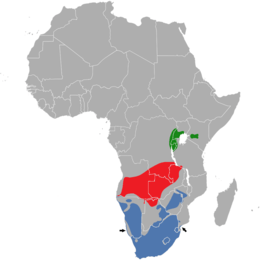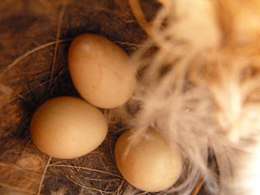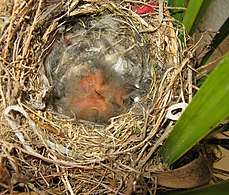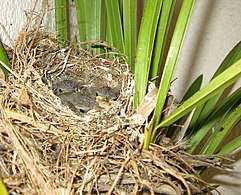Cape wagtail
The Cape wagtail (Motacilla capensis), also known as Wells's wagtail, is a small insectivorous bird which is widespread and fairly common in the southern Afrotropics, and occurs besides in some uplands of tropical Africa. It frequents water's edge, lawns and gardens. It is a mostly resident, territorial species, but they may undertake limited altitudinal migration or form flocks outside the breeding season.[3] Like other wagtails they are passerine birds of the family Motacillidae, which also includes the pipits and longclaws.
| Cape wagtail | |
|---|---|
.jpg) | |
| M. c. subsp. wellsi at Lake Bunyonyi, Uganda | |
| Scientific classification | |
| Kingdom: | Animalia |
| Phylum: | Chordata |
| Class: | Aves |
| Order: | Passeriformes |
| Family: | Motacillidae |
| Genus: | Motacilla |
| Species: | M. capensis |
| Binomial name | |
| Motacilla capensis | |
 | |
| Range, showing subspecies:
Motacilla capensis subsp. wellsi Motacilla capensis subsp. simplicissima Motacilla capensis subsp. capensis | |
Taxonomy
In 1760 the French zoologist Mathurin Jacques Brisson included a description of the Cape wagtail in his Ornithologie based on a specimen collected from the Cape of Good Hope. He used the French name La bergeronette du Cap de Bonne Espérance and the Latin Motacilla Capitis Bonae Spei.[4] Although Brisson coined Latin names, these do not conform to the binomial system and are not recognised by the International Commission on Zoological Nomenclature.[5] When in 1766 the Swedish naturalist Carl Linnaeus updated his Systema Naturae for the twelfth edition, he added 240 species that had been previously described by Brisson.[5] One of these was the Cape wagtail. Linnaeus included a brief description, coined the binomial name Motacilla capensis and cited Brisson's work.[6] The genus Motacilla had been introduced in 1758 by the Linnaeus in the tenth edition of his Systema Naturae.[7] The specific name capensis denotes the Cape of Good Hope.[8]
Three subspecies are currently recognized,[9] which occur in three rather discrete regions:[3]
- Motacilla capensis subsp. simplicissima Neumann, 1929 – Angola to southeastern DRCongo, Zambia, the Caprivi Strip, northern Botswana and westernmost Zimbabwe
- Motacilla capensis subsp. capensis Linnaeus, 1766 – Namibia, South Africa, Lesotho, Swaziland, Zimbabwe and central Mozambique
- Motacilla capensis subsp. wellsi Ogilvie-Grant, 1911 – Highlands of the eastern DRCongo to Uganda and Kenya
Description
The Cape wagtail is a rather dull plumaged and relatively short tailed wagtail with olive grey upperparts and face with a buff supercilium and dark lores. The underparts are creamy white and may show a faint pinkish wash on the lower breast and belly. The breast band is dusky and the sides of the breast and the flanks are olive-grey. The brownish black wings have pale edges to the feathers and the tail is blackish with the two outer tail feathers being white. The juveniles are similar to the adults but browner above and yellower below.[10]
Distribution and habitat
Cape wagtails are found in eastern and southern Africa from Uganda, the eastern DRCongo and Kenya, through Zambia and Angola to southern Africa, south to the Western Cape and the Cape of Good Hope.[11]
Cape wagtails can be found in almost any habitat that has open ground adjacent to water, and also along the rocky coastline, in farms, villages, cultivated land, parks, gardens and urban centres.[11] In east Africa it is generally found above 2,000 m (6,600 ft) in altitude.[10]
Behaviour
The Cape wagtail's main food is invertebrates foraging is mainly on the ground or in shallow water, often feeding on animals that are already dead. It has been recorded taking insects attracted to lights in the early morning or caught in car radiators. Other than insects it has been recorded as eating fiddler crabs, sandhoppers, snails, ticks, tadpoles, small fish, small chameleons and human food.[11]
The Cape wagtail is a monogamous, territorial solitary nester and breeding pairs stay together over a number of breeding seasons. Like many territorial birds the males often fiercely attack their own reflection in mirrors or windows. The nest is built by both sexes and consists of a cup made of a wide range of materials, both natural and artificial, which is lined with hair, rootlets, wool and feathers. The nest is situated in a recess within a steep bank, tree, bush or frequently sited in a man-made site, such as a hole in a wall, pot plant or bridge. It breeds all year round but, egg-laying peaks from July until December. One to five eggs are laid, which both sexes incubate for 13–15 days. Once hatched the chicks are fed by both parents, until they leave the nest after 14–18 days. Once fledged they adults continue to feed them for another 20–25 days, and the young become fully independent after 44 days from fledging, occasionally up to 60 days.[11]
It has been recorded as host of the following brood parasites diderick cuckoo Chrysococcyx caprius, Jacobin cuckoo Clamator jacobinus and Levaillant's cuckoo Clamator levaillantii. Predators include the rufous-breasted sparrowhawk Accipter rufiventris, as well as cats and rats Rattus spp.[11]
Gallery
 Off-white egg of the nominate subspecies – the base colour and markings are very variable[3]
Off-white egg of the nominate subspecies – the base colour and markings are very variable[3] A clutch of three eggs in a nest, three being the average number
A clutch of three eggs in a nest, three being the average number Three 2 days old chicks – the chicks may hatch on the same or on successive days
Three 2 days old chicks – the chicks may hatch on the same or on successive days Three 13 days old chicks – the average nestling period is 16 days[3]
Three 13 days old chicks – the average nestling period is 16 days[3]
References
- "Motacilla capensis (Cape Wagtail)". IUCN Red List of Threatened Species. Retrieved 22 October 2016.
- "Cape Wagtail Motacilla capensis Linnaeus, 1766". Avibase. Denis Lepage. Retrieved 22 October 2016.
- Hockey, P. A. R.; Dean, W. R. J.; Ryan, P. G. (2005). Roberts Birds of Southern Africa (7th ed.). Cape Town: Trustees of the John Voelcker Bird Book Fund. pp. 1091–1092. ISBN 0-620-34053-3.
- Brisson, Mathurin Jacques (1760). Ornithologie, ou, Méthode contenant la division des oiseaux en ordres, sections, genres, especes & leurs variétés (in French and Latin). Volume 3. Paris: Jean-Baptiste Bauche. pp. 476–478, Plate 25 fig 3. The two stars (**) at the start of the section indicates that Brisson based his description on the examination of a specimen.
- Allen, J.A. (1910). "Collation of Brisson's genera of birds with those of Linnaeus". Bulletin of the American Museum of Natural History. 28: 317–335.
- Linnaeus, Carl (1766). Systema naturae : per regna tria natura, secundum classes, ordines, genera, species, cum characteribus, differentiis, synonymis, locis (in Latin). Volume 1, Part 1 (12th ed.). Holmiae (Stockholm): Laurentii Salvii. p. 333.
- Linnaeus, Carl (1758). Systema Naturae per regna tria naturae, secundum classes, ordines, genera, species, cum characteribus, differentiis, synonymis, locis (in Latin). Volume 1 (10th ed.). Holmiae:Laurentii Salvii. p. 184.
- Jobling, J.A. (2018). del Hoyo, J.; Elliott, A.; Sargatal, J.; Christie, D.A.; de Juana, E. (eds.). "Key to Scientific Names in Ornithology". Handbook of the Birds of the World Alive. Lynx Edicions. Retrieved 2 May 2018.
- Gill, Frank; Donsker, David, eds. (2018). "Waxbills, parrotfinches, munias, whydahs, Olive Warbler, accentors, pipits". World Bird List Version 8.1. International Ornithologists' Union. Retrieved 2 May 2018.
- Zimmerman, Dale A.; Turner, Donald A.; Pearson, David J. (1996). Birds of Kenya and Northern Tanzania. Helm. pp. 505–506. ISBN 0-7136-3968-7.
- "Motacilla capensis (Cape wagtail)". Biodiversity Explorer. Iziko Museums of South Africa. Retrieved 22 October 2016.
- Sinclair, Hockey and Tarboton, SASOL Birds of Southern Africa, ISBN 1-86872-721-1
External links
| Wikimedia Commons has media related to Motacilla capensis. |
- Cape wagtail - Species text in The Atlas of Southern African Birds.
